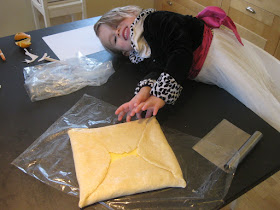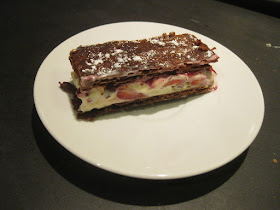April 29, 2013
Lardo - the tasty cured pig fat
Much of what you eat in charcuterie is fat, whether it is marbled in to a whole muscle like coppa or ground up in chunks of various size in a cured sausage like sopressata. Since becoming interested in this pursuit I had read about straight up cured fat, or lardo. Like the average american I was a little intimidated by this concept, but Becky is more intrepid than I when it comes to weird meat and fat eating and thought it sounded promising.
April 26, 2013
Darn it! - and other mending
April 11, 2013
Enterprise #5 antique meat grinder
This is the cute little brother of the Enterprise #10 meat grinder which I detailed in a previous post. I actually bought this one first, off ebay, but later developed the opinion that this one was not going to cut it and I'd better go to the next size up. After overhauling the #10 and getting it working well, I wanted to tune up the #5 and sell it off on ebay. But now that I have it working in top form, I'm instead thinking of selling the #10!
You can see the #5 compared to the larger #10 below. The #5 has a smaller diameter screw and barrel, the barrel length and crank radius are shorter, and the cutting face area is smaller.
One reason why I didn't like the prospects of the #5 initially was that the replacement cutter I bought for it did not fit well on the square boss on the end of the extrusion screw.
I was concerned that under load, it would eventually strip or otherwise munge itself into non-functionality. But I figured I ought to give it a try so I could sell it in good conscience.
I cleaned it thoroughly, then applied furniture wax to the outside surfaces and shortening to the inside surfaces, baked in with the oven. I also found a thrust washer to put between the screw and the housing, but it pushes the cutter plate out too far such that it doesn't engage with the anti-rotation pin in the end of the barrel. I guess it will still outlast me even with no thrust washer in there.
The first thing I did with it was to grind up a load of semi-frozen beef heart for some chili Becky was making up.
With the 12mm plate on, it went through beautifully in a couple minutes. A big pile of quivering fresh ground beef heart is something you don't see everyday, and really makes you think about your dedication to eating meat.
I found the #5 easier to clean than the #10. A scrub brush can still mostly fit down the barrel and into the hopper, and fingers and a sponge can more easily access the internal facets that need cleaning. Since the cutting face has less area, there are fewer holes in the cutter plate to poke out and clean, and overall the pieces are a little lighter and easier to handle in the sink.
I put the #5 to a tougher test; grinding up sprouted einkorn for bread. The kids have a little easier time turning the crank on the #5 than on the #10.
It did a fine job on the sprouts. As a final test, we made 2kg of breakfast sausage from a nice, fatty chunk of shoulder I got from our neighborhood boutique butcher.
For this sausage, I followed the recipe in Charcuterie, by Polcyn and Keller, but substituted homebrew hard cider for the water added at the binding stage.
I manually cubed the meat, mixed in the spices and salt, then chilled it for a while in the freezer before we started.
The kids did almost all the cranking and feeding.
For some reason, they can't get enough of the cranking!
Millie found the cranking a bit tough.
Child 1 is helping me pour the liquid in before the binding mix in the picture below. One of his favorite things is to "dump" something, and he has very little ability to discriminate when it is appropriate to do so. He also is in love with the mixer, so he was all over this step.
Child 1 and I dumped the sausage filling onto a length of saran wrap to form two big quenelles.
These got put in the freezer for a while, until they were very firm but not completely frozen, then were sliced up and frozen in zip bags.
Yum!
So all in all I have been very impressed with the #5. It has a lower throughput than the #10, but for the amount of stuff I'm grinding at a time the actual grinding time is a lot less than the prep and cleanup time. So an increase in grinding time from 5 minutes to 10 minutes in not very significant, and probably gets recouped in a shorter cleaning time. The machine is lighter and smaller, and a little easier for the kids to crank. There are not as many plate options available, but I have honestly been happy with the output from the 5 and 12 mm plates I already have. The hopper is significantly smaller, so when the kids are feeding it there tends to be more misses and stuff ending up on the floor than with the #10.
I'll keep the #10 around for a while longer just to make sure the #5 isn't going to strip, break, or be found inadequate for some task I have yet to undertake. But after a year of not using the #10, I vow to find it a new home.
April 8, 2013
Puff pastry
Now that we are not vegans, we again eat tremendous quantities of butter every week. I began to ask myself "Why in the world are we not eating some of that butter in the form of puff pastry?!"
I've wanted to make puff pastry for some time now, but had not actually undertaken it until a few months ago. Becky has made it before, and is a very dedicated lover of the stuff. Now that I've made two batches of it, I'd say its a worthwhile thing to do at home; not all that much harder than making and preparing a pie crust from scratch.
Puff pastry is a laminated dough, constructed by creating by surrounding a layer of butter with lean pastry dough (the detrempe), then multiple iterations of rolling out and folding over to get the power of exponentials working for you in creating lots of layers.
I used 450g of Kerrygold butter to start.
This butter is has excellent flavor, and is unusually plastic even at low temperatures, which is helpful in the puff pastry process. The butter blocks were floured a bit, then rolled out mildly between plastic.
The recipe I used was from Joy of Cooking, and Child 1 helped me mix the detrempe in the food processor, as I do with pie dough.
We dumped it out
Consolidated it
then rolled it out between plastic wrap.
The butter went on top
and was enfolded by the rolled out dough.
This package was then rolled out to prepare for the first "turn" or set of lamination folds.
I folded in thirds, with 7 turns total, which resulted in 2187 layers (=3^7).
The dough goes in the fridge for an hour between turns. At the end, I divided it into four portions and froze 3 of them for later.
For the first test, I sliced the rolled out piece into ~30mm wide strips and baked them at 400C until they looked done. The pastry puffed up tremendously, so I actually pulled each strip apart to make a napoleon sandwich. These tasted great, but next time I decided to look up how other people get their layers of baked pastry so uniform looking.
With the next 1/4, I mostly followed the directions at the Joe Pastry blog. After rolling out, we pricked the pastry with a fork prior to baking:
Then we trimmed the edges
Of course the trimmings don't go to waste, with the help of some cinnamon and sugar!
Next we baked it between cookie pans at 200C for about 20 minutes.
Then took the top pan off and baked for another 5 minutes, which unfortunately burned the *&#$ out of the pastry. Maybe it was rolled too thin? Argghh!
While the pastry was baking we prepared the filling. The previous day we had made a batch of custard pastry cream, also from Joy of Cooking. We took an equal volume of fresh cream (supplemented with some creme fraiche since we were short on cream) and whipped it up in the kitchen aid.
The pastry cream was combined with the whipped cream to make a lighter filling.
Even though the pastry was pretty burned, we were not about to let it go to waste, so we made up our little napoleons with the filling, freshly sliced strawberries, and some of my mom's tart blackberry jam.
Final cutting was after filling, which tended to squish the filling out a bit.
This was quickly eaten up, despite its shortcomings.
Unfortunately this was the last of the first batch of puff pastry (Becky had used 1/2 the batch to top a steak pie) so I couldn't have another shot at napoleons to try to correct my shame until I made another batch.
I did this within a few weeks, but I added a bit too much water to the detrempe so it was too soft and allowed the butter to break through too easily. Consequently, the pastry came out tougher and not as delicious as the first batch. Still edible, certainly.
For fruity napoleons try #2, I resolved to pay more attention to the pastry after removing the top pan, this time after only 15 minutes at 200C.
But it started to burn literally one minute after I took the top off. Grrr!
We prepared these with the same fillings, but tried to cut them prior to filling.
These had an issue of the filling getting squished out when you tried to eat them or cut them with the fork. I guess I need to go to multiple layers with less filling in between.
Once again, even though they were not perfect, there were no leftovers.
Clearly I still need work on my napoleon skills. Even partially successful efforts yield tasty results though.
April 4, 2013
I love my iron! (and ironing board)
One of the most essential tools for making sewing easier, faster, and better is a good iron. There is a post on this topic over at Male Pattern Boldness right now, and I felt the need to expound robustly on the subject to such an extent that I thought I'd better make a blog post out of it rather than clogging up the comments section on Peter's site with my blather.
I learned to sew ~12 years ago while taking some excellent pattern design classes in night school at Mass. Art, and we had gravity feed irons in class. They are definitely a different animal, with their own set of pros and cons. There must be very good reasons that they are de rigueur for people who do this for a living, and using one in class certainly opened my eyes to the inadequacy of the entirely typical garbage iron I was using at home.
It wasn't long until the dastardly home iron piddled on a sewing project of mine one too many times, and I resolved to get something better.















































